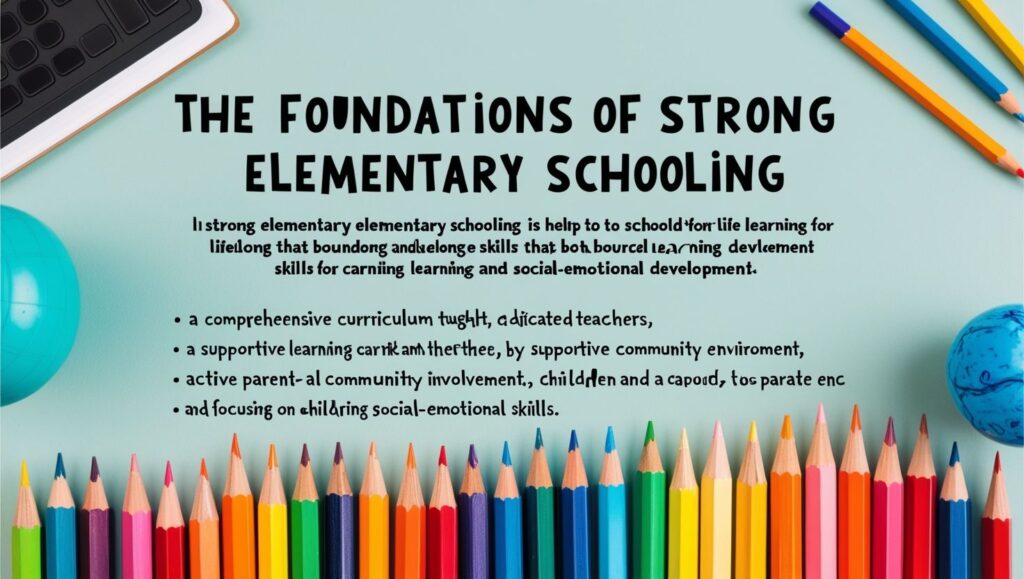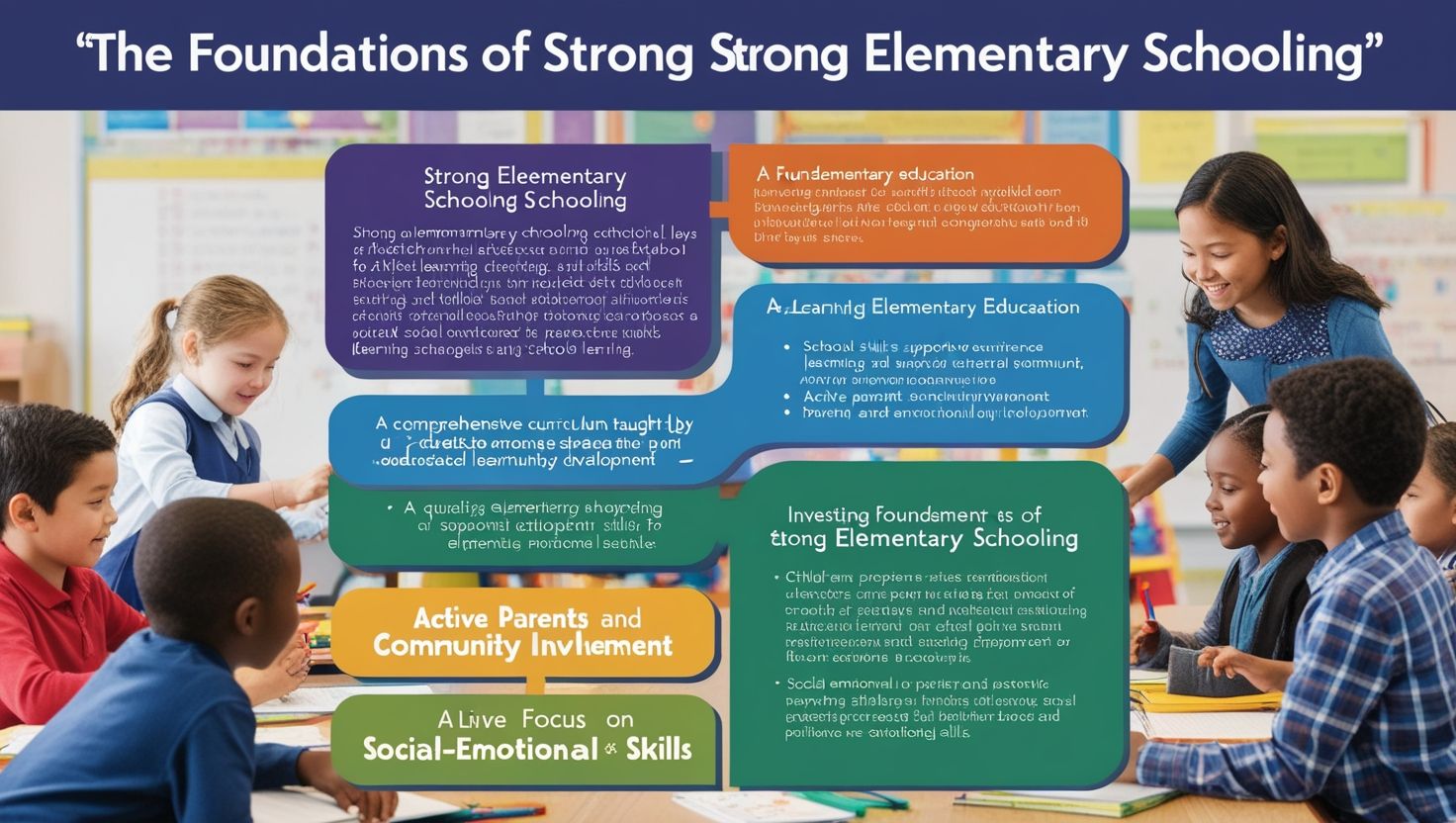The Foundations of Strong Elementary Schooling, Elementary schooling serves as a critical foundation in a child’s educational journey. A strong elementary education equips students with fundamental academic, social, and emotional skills, setting the stage for lifelong learning and success. This article explores the essential elements of robust elementary schooling, its benefits, and its impact on future academic achievements and personal growth.
Key Components of Strong Elementary Schooling
1. Quality Curriculum and Instruction
One of the cornerstones of strong elementary schooling is a well-rounded and comprehensive curriculum. A robust curriculum covers core academic subjects, including literacy, mathematics, science, and social studies, while integrating the arts, physical education, and often language learning. This breadth in education not only provides children with a varied knowledge base but also helps in discovering their strengths and interests early on.
Effective instruction, delivered by qualified and committed teachers, is equally vital. Teachers in strong elementary schools use diverse teaching methods to address different learning styles, encouraging critical thinking, creativity, and problem-solving skills. Instructional methods like active learning, collaborative projects, and inquiry-based tasks make learning interactive and engaging, ensuring students stay motivated and enthusiastic about their studies. High-quality teaching also involves regular assessments and feedback to monitor each student’s progress and adjust the teaching approach when necessary.
2. Supportive Learning Environment
A strong elementary school provides a safe and supportive learning environment where children feel secure and valued. An inclusive atmosphere that respects diversity and promotes acceptance helps children develop confidence, self-worth, and a positive outlook toward school. According to the Collaborative for Academic, Social, and Emotional Learning (CASEL), a positive school climate contributes to students’ social-emotional well-being and academic success.
Classroom management and school-wide routines are essential for maintaining this supportive environment. Clear expectations for behavior and respectful interactions encourage discipline and respect among students, creating an atmosphere conducive to learning. Furthermore, schools that foster strong relationships among students, teachers, and staff build a sense of community and belonging, which is particularly crucial in the elementary years.
3. Parental and Community Involvement
Parental involvement is one of the most significant factors contributing to a child’s success in elementary school. Active engagement of parents in their child’s education strengthens the child’s connection to school and reinforces learning at home. Research suggests that students whose parents participate in school activities and monitor their academic progress tend to have higher attendance rates, better grades, and more positive attitudes toward learning (Henderson & Mapp, 2002).
Schools with robust parental involvement programs often have regular communication channels that update parents on academic progress, behavioral expectations, and upcoming activities. Additionally, community involvement, such as partnerships with local organizations, enriches the educational experience. Community resources like public libraries, local museums, and guest speakers introduce students to real-world applications of their learning, reinforcing the idea that education extends beyond the classroom.

4. Development of Social and Emotional Skills
A strong elementary education does not focus solely on academics; it also prioritizes the development of social and emotional skills. Social-emotional learning (SEL) is the process through which students learn to understand and manage their emotions, set and achieve goals, establish positive relationships, and make responsible decisions. According to a study published in the journal Child Development, SEL programs can lead to improved classroom behavior, better academic performance, and reduced emotional distress in children (Durlak et al., 2011).
Schools that incorporate SEL into the curriculum help students develop skills like empathy, teamwork, and conflict resolution, which are essential for academic and personal success. Teachers trained in SEL create a more empathetic and emotionally responsive classroom, where students feel comfortable expressing themselves and navigating their social interactions. These skills are foundational for elementary students, helping them build resilience and adaptability for challenges they may face in later years.
The Impact of Strong Elementary Schooling on Future Learning
The impact of strong elementary schooling extends beyond the early grades, significantly influencing students’ future academic achievements and personal development. Studies consistently show that a solid elementary education is correlated with higher graduation rates, better career opportunities, and positive mental health outcomes (Heckman, 2006). Children who receive a strong foundation in elementary school tend to perform better in higher education due to their established study habits, critical thinking abilities, and positive attitudes toward learning.
Additionally, strong elementary schooling fosters lifelong learners who are more likely to pursue further education and skills development as adults. When students experience early success and feel supported, they are more inclined to take on academic challenges with a growth mindset. This proactive approach to learning encourages students to seek knowledge independently, pursue personal goals, and stay curious and adaptable in a rapidly changing world.
Challenges in Implementing Strong Elementary Education
Despite the clear benefits, implementing a strong elementary education system faces several challenges. Funding and resource limitations, particularly in low-income areas, often hinder schools from providing a comprehensive curriculum, extracurricular programs, and sufficient support staff. Teacher shortages and high turnover rates in some regions also impact the quality of education, as students benefit greatly from stability and continuity in their early learning years.
Moreover, the emphasis on standardized testing can sometimes overshadow holistic education, reducing time and resources dedicated to subjects like the arts, physical education, and SEL. Policymakers, educators, and communities need to recognize and advocate for the importance of a balanced approach to elementary education that values both academic performance and the development of well-rounded individuals.
Conclusion
A strong elementary education is foundational for lifelong success, as it provides children with essential academic skills, a positive learning environment, and the support needed to develop socially and emotionally. The combined efforts of schools, families, and communities contribute significantly to the effectiveness of elementary education. By prioritizing quality curriculum, supportive environments, parental involvement, and social-emotional learning, schools can lay a solid groundwork that enables students to thrive academically, socially, and emotionally throughout their lives.
Investing in strong elementary schooling is not only beneficial for individual students but also crucial for building a society of knowledgeable, empathetic, and capable future citizens. As educational research continues to shed light on the components of effective elementary schooling, communities have the opportunity to strengthen these practices and provide every child with the best possible start on their educational journey.
References
- CASEL. (2020). What is SEL? Retrieved from https://casel.org/
- Durlak, J. A., Weissberg, R. P., Dymnicki, A. B., Taylor, R. D., & Schellinger, K. B. (2011). The impact of enhancing students’ social and emotional learning: A meta-analysis of school-based universal interventions. Child Development, 82(1), 405-432.
- Henderson, A. T., & Mapp, K. L. (2002). A new wave of evidence: The impact of school, family, and community connections on student achievement. Southwest Educational Development Laboratory.
- Heckman, J. J. (2006). Skill formation and the economics of investing in disadvantaged children. Science, 312(5782), 1900-1902.

6 thoughts on “The Foundations of Strong Elementary Schooling”
Comments are closed.